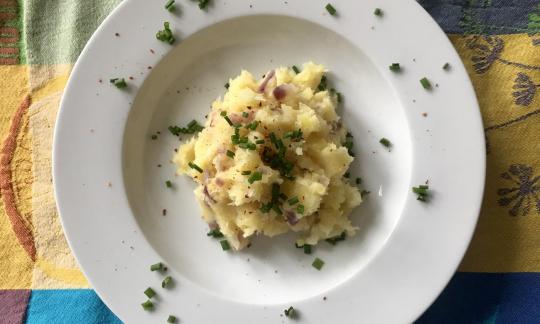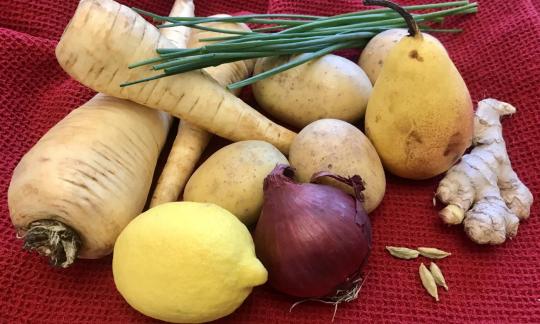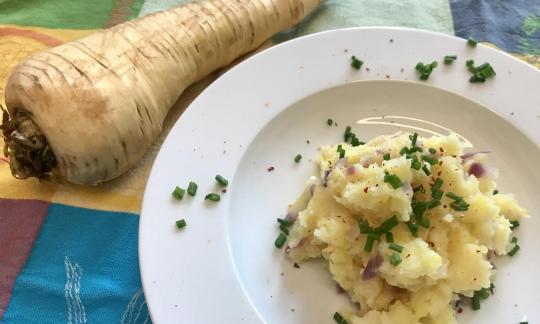Spicy parsnip-potato puree
vegan
Ingredients (for servings, )
| basic ingredients for the soup | |
|---|---|
| 8 ½ oz | Parsnips, raw (organic?) |
| 8 ½ oz | Potatoes, raw (organic?) |
| 2 | Cardamom (cardamom, cardamom, cardamom) (0.01 oz) |
| ½ TL, gerieben | Ginger, raw (organic?) (0.05 oz) |
| 1 | Onions, red (raw, organic?) (2.8 oz) |
| ½ tsp | Chili flakes (raw?, organic?) (0.08 oz) |
| Optional | |
| 1 dash | Table salt (table salt, raw?, organic?) (0.01 oz) |
| ½ oz | Chives, raw (organic?) |
| 60 ml | Oat milk (oat drink, raw?, organic?) (2.1 oz) |
Equipment
- steamer basket
- grater
- mortar
- vegetable peeler
- skillet (frying pan)
- stove
- saucepan
- potato ricer or potato masher
Type of preparation
- chop or grind
- steam
- dry roast
- season to taste
- purée
- peel
- grate (shred)
Preparation
Preparing the ingredients
Heat water in a pot with a steamer. Peel the parsnips and potatoes, cut into cubes and place in the steamer. Steam the vegetables for about 10-15 minutes.During the steaming time, proceed to step 2.
Preparing the remaining ingredients
Remove the cardamom from the pod and grind in a mortar. Grate the ginger. Peel the onion and dice finely. First, put the onion in a small coated pan with a little water and sauté briefly until the water is used up and the onions start to stick slightly. After about 3 minutes, add about 1 tablespoon of water and the cardamom and ginger and sauté for another minute. Wash the chives and cut into fine rings.We used green cardamom in this dish. For information on the differences between green and black cardamom, click on the ingredient or see "Recipe Notes".
Completing the dish
Mash the vegetables from step 1 with a potato masher. Add the oat milk and heat again. Add the onion, ginger and cardamom and season with chili flakes. Add a little salt if necessary.Sprinkle with chives and serve.
Portion information: The specified amount of 2 portions is sufficient for 2 side dishes.
Oat milk: Add as much oat milk until you get the desired consistency.
|
Nutritional Information per person
Convert per 100g
|
2000 kcal | |
|---|---|---|
| Energy | 225 kcal | 11.2% |
| Fat/Lipids | 1.1 g | 1.5% |
| Saturated Fats | 0.19 g | 1.0% |
| Carbohydrates (inc.dietary fiber) | 51 g | 19.0% |
| Sugars | 11 g | 12.1% |
| Fiber | 10 g | 40.3% |
| Protein/Albumin | 5.1 g | 10.2% |
| Cooking Salt (Na:116.1 mg) | 295 mg | 12.3% |
| Essential micronutrients with the highest proportions | per person | 2000 kcal | |
|---|---|---|---|
| Vit | Vitamin C (ascorbic acid) | 54 mg | 67.0% |
| Vit | Vitamin K | 50 µg | 66.0% |
| Vit | Vitamin B9, B11 (Folate, as the active form of folic acid) | 120 µg | 60.0% |
| Elem | Potassium, K | 1'118 mg | 56.0% |
| Min | Manganese, Mn | 1.1 mg | 56.0% |
| Vit | Vitamin B6 (pyridoxine) | 0.58 mg | 42.0% |
| Min | Copper, Cu | 0.32 mg | 32.0% |
| Elem | Phosphorus, P | 190 mg | 27.0% |
| Vit | Vitamin B1 (Thiamine) | 0.27 mg | 24.0% |
| Elem | Magnesium, Mg | 78 mg | 21.0% |
Detailed Nutritional Information per Person for this Recipe
The majority of the nutritional information comes from the USDA (US Department of Agriculture). This means that the information for natural products is often incomplete or only given within broader categories, whereas in most cases products made from these have more complete information displayed.
If we take flaxseed, for example, the important essential amino acid ALA (omega-3) is only included in an overarching category whereas for flaxseed oil ALA is listed specifically. In time, we will be able to change this, but it will require a lot of work. An “i” appears behind ingredients that have been adjusted and an explanation appears when you hover over this symbol.
For Erb Muesli, the original calculations resulted in 48 % of the daily requirement of ALA — but with the correction, we see that the muesli actually covers >100 % of the necessary recommendation for the omega-3 fatty acid ALA. Our goal is to eventually be able to compare the nutritional value of our recipes with those that are used in conventional western lifestyles.
| Essential fatty acids | per person | 2000 kcal |
|---|---|---|
| Linoleic acid; LA; 18:2 omega-6 | 0.34 g | 3.0% |
| Alpha-Linolenic acid; ALA; 18:3 omega-3 | 0.02 g | 1.0% |
| Essential amino acids | per person | 2000 kcal |
|---|---|---|
| Tryptophan (Trp, W) | 0.04 g | 16.0% |
| Threonine (Thr, T, irreversibly transaminated) | 0.11 g | 12.0% |
| Valin (Val, V) | 0.16 g | 10.0% |
| Isoleucine (Ile, I) | 0.11 g | 9.0% |
| Lysine (Lys, K, irreversibly transaminated) | 0.18 g | 9.0% |
| Phenylalanine (Phe, F) | 0.13 g | 9.0% |
| Leucine (Leu, L) | 0.17 g | 7.0% |
| Methionine (Met, M) | 0.05 g | 5.0% |
| Vitamins | per person | 2000 kcal |
|---|---|---|
| Vitamin C (ascorbic acid) | 54 mg | 67.0% |
| Vitamin K | 50 µg | 66.0% |
| Vitamin B9, B11 (Folate, as the active form of folic acid) | 120 µg | 60.0% |
| Vitamin B6 (pyridoxine) | 0.58 mg | 42.0% |
| Vitamin B1 (Thiamine) | 0.27 mg | 24.0% |
| Vitamin B5 (Pantothenic acid) | 1.2 mg | 21.0% |
| Vitamin E, as a-TEs | 2.1 mg | 17.0% |
| Vitamin B3 (Niacin) | 2.5 mg | 16.0% |
| Vitamin B2 (Riboflavin) | 0.14 mg | 10.0% |
| Vitamin B7 (Biotin, ex vitamin H) | 2.5 µg | 5.0% |
| Vitamin A, as RAE | 31 µg | 4.0% |
| Essential macroelements (macronutrients) | per person | 2000 kcal |
|---|---|---|
| Potassium, K | 1'118 mg | 56.0% |
| Phosphorus, P | 190 mg | 27.0% |
| Magnesium, Mg | 78 mg | 21.0% |
| Sodium, Na | 116 mg | 15.0% |
| Calcium, Ca | 82 mg | 10.0% |
| Essential trace elements (micronutrients) | per person | 2000 kcal |
|---|---|---|
| Manganese, Mn | 1.1 mg | 56.0% |
| Copper, Cu | 0.32 mg | 32.0% |
| Iron, Fe | 2.2 mg | 16.0% |
| Zinc, Zn | 1.4 mg | 14.0% |
| Selenium, Se | 3.1 µg | 6.0% |
| Iod, I (Jod, J) | 5.9 µg | 4.0% |
| Fluorine, F | 0.44 µg | < 0.1% |
The oriental parsnip and potato puree does not require any salt thanks to gentle preparation and intensive ingredients.
Portion information: The specified amount of 2 portions is sufficient for 2 side dishes.
Nutrient profile: One serving of this recipe provides more than half of the average daily requirement of vitamin C, vitamin K, potassium and folic acid. Over a third of manganese, vitamin B6 (pyridoxine) and copper are also included.
Parsnip: The parsnip has a sweet, spicy, sometimes bitter taste. Parsnips are similar to parsley root, but have a milder taste. They not only stimulate the appetite, but also have a diuretic effect.
Cardamom: Cardamom, which comes from India, is not only a very old spice, but is also one of the most expensive of its kind, along with vanilla and saffron threads. This is due, among other things, to the irregular and labor-intensive harvesting conditions. In addition to its frequent use in cooking, especially in Asian countries, it is also used for medicinal purposes. A distinction is made between black cardamom ( Amomum subulatum), which is generally used for preparing hearty and spicy dishes due to its bitter and earthy aroma, and green cardamom ( Elettaria cardamomum), which is preferably used as an ingredient in spice mixtures and desserts due to its sweet and spicy aroma. We used green cardamom in this dish.
Ginger: The ginger rhizome has an aromatic smell and a sharp and spicy taste, which is due to the substance gingerol, which is said to have anti-carcinogenic and anti-inflammatory effects. The substances borneol and cineole give ginger its digestive, antiemetic, appetite-stimulating and circulatory properties.
Chives: Chives are a popular herb for flavoring raw or cooked dishes. They contain traces of sulfur and are very rich in vitamin K. Just 35 grams provide practically 100% of the recommended daily potassium requirement.
Omit salt and oil: We have deliberately omitted salt and oil for health reasons. The seasoning of the ingredients and the gentle preparation by steaming give the soup an intense flavor. You can find more information on this topic in the book we describe in detail: "Salt Sugar Fat" by Michael Moss.
Steaming versus cooking: The advantage of steaming compared to cooking is that hardly any ingredients are lost and the taste remains more intense.
You can also use parsley root instead of parsnips, but the latter has a more intense flavor and a slightly different texture.
Herbs: You can use fresh coriander in addition to or in place of chives, which harmonizes very well with the ingredients.
Cardamom: Because cardamom has a very intense flavor, use it with caution, especially if you are not familiar with the taste. If in doubt, use less or leave it out altogether.








